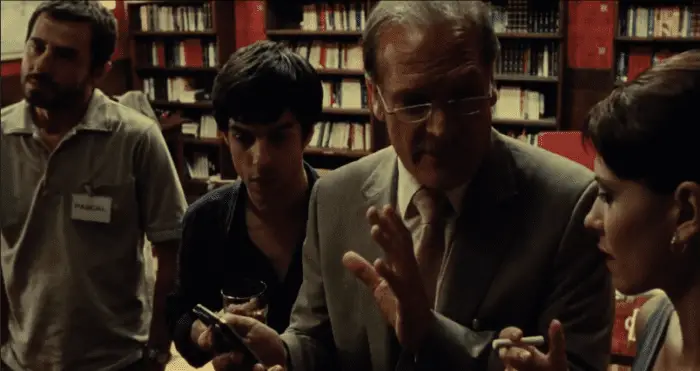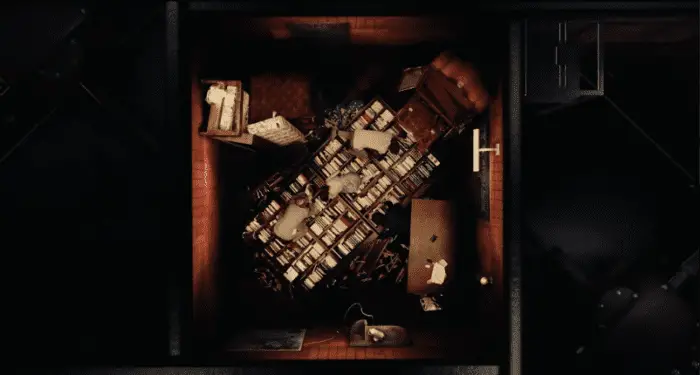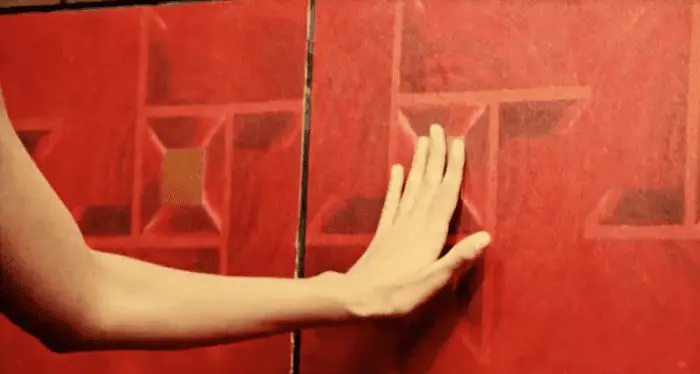Puzzle room (or escape room) horror is a subgenre that has become more and more popular with releases such as the four recent films by the same suitable title, Escape Room (Will Wernick, 2017, Peter Dukes, 2017, Alex Merkin, 2018, and Adam Robitel, 2019). These are more overtly part of the same category, but the type of film itself has been around for a while now in many varied forms. Cube (Vincenzo Natali, 1997), one of the first kind of puzzle room films, is science fiction horror. The most famous and influential entry, also renowned for pioneering the torture porn genre, Saw (James Wan, 2004), is a blend of gory horror, psychological thriller, and action film. Then we have Fermat’s Room or La habitación de Fermat (Luis Piedrahita and Rodrigo Sopeña, 2007), a Spanish psychological thriller that moves away from gore or other specific horror genre aspects, instead favouring an exploration of character dynamics alongside math-themed puzzles.
Four mathematicians receive a math puzzle from a stranger using the alias ‘Fermat,’ and upon solving it, they are invited to a specific location to solve a ‘great enigma.’ They also are asked not to bring mobile phones with them, and are made to use aliases named after famous historical mathematicians: Galois (a sincere, middle-aged inventor), Oliva (a quiet, dignified young woman), Pascal (an arrogant young math prodigy), and Hilbert (an eccentric older man). Arriving at a river bank, the four people see a car flash its headlights across the water, and realise they must row across. The car contains a PDA with GPS instructions, leading them to an abandoned warehouse. One of the rooms, an elegant parlour filled with bookcases, has a large dining table with five places set.
The eponymous Fermat, an elderly man, enters and introduces himself, discussing various relevant topics as they all eat dinner with him. A phone call about his comatose daughter causes him to rush out, forgetting his coat and wallet. It’s after this point that math puzzles begin coming through on the PDA with a time limit of one minute. If the participants don’t solve it in time, the walls slowly close in on them until they submit the correct answer. From their calculations, it will only take an hour until the room is “the size of an elevator.” Tension and conflict escalate between the four people throughout, and so does the sense of claustrophobia as the room becomes smaller and smaller. There are a few cutaways to Fermat himself as he attempts to visit his daughter and return to the warehouse, getting killed along the way, but the majority of the runtime is spent observing the participants in (or above) Fermat’s room.

Similarities with other puzzle room horror films appear to be quite standard on the surface: a select group of people with tension between them for initially unknown reasons, having to solve puzzles within a time limit, impending physical harm and death, etc. As is also the case in the most recent 2019 film, Escape Room, the participants must solve a math-related problem before receiving their invitation, almost as a confirmation of their abilities. However, Fermat’s room is a rather simplified version; it involves a limited number of people in a singular, small room having to solve straightforward riddles, and the only danger is the slowly closing-in walls as opposed to multiple elaborate or varied traps. Despite all the participants being extremely intelligent mathematicians, the puzzles are all rather regular riddles, solvable by your average person. I actually recognised the riddle about the hourglasses set at different times from a Professor Layton game, which was quite amusing. However, it’s understandable why this decision was made, as involving complex math would alienate a large percentage of the audience—this way, we can play along with them, adding a level of relatability to the experience of viewing the film.
As a whole, Fermat’s Room is very self-contained, much like Cube, with even less plot occurring outside of the room itself once the participants arrive, but enough to evoke the sense that there is something larger at play. One way in which Piedrahita and Sopeña convey this is with the use of bird’s eye (or God’s eye) view shots. The poster itself depicts one of these shots which recurs a couple of times throughout the film: a zoomed-out bird’s eye shot of the room. A perfect square with lines extending out from each corner, Fermat’s room is shaped like the patterns in the wallpaper, emphasising that all the answers leading to their escape are within that space. Looking directly from above gives the impression of a floor plan, or a doll’s house intersected horizontally instead of vertically. The opening credits have the same feel, showing shots of the room replicated in a scaled-down model, so small that the chairs need to be picked up and placed using tweezers. Each of the participants appear to be pawns in a game to be moved around in the same way as the furniture—their autonomy is removed in this respect, and they feel more like objects from this perspective.

Another instance of a bird’s eye view shot is when Fermat has been poisoned via a gas released from him securing his seatbelt in his car. This comes shortly after the reveal that Fermat was a diversion to prevent the participants from suspecting Hilbert, the real mastermind behind the event. Once Fermat clicks his seatbelt in place, the audience instantly realises he will die, and the camera switches to a long, bird’s eye tracking shot that follows the car along the road until it veers off into the dark woods, and we know he’s dead. The detachment of this shot is tactful yet ominous, and the drawn-out duration effectively builds our feeling of dread, knowing for a fact this man’s life will end. It makes us feel like spectators at an execution.
This is very much the same voyeuristic feeling of watching the four mathematicians try to escape in Fermat’s room. Where Saw explores dynamics between the characters trapped in the games and the psychological conflict between them (more so in the earlier films) alongside occurrences of brutal violence and gore, Fermat’s Room focuses on the former aspects, moving so far away from the latter that we see no blood whatsoever throughout the film. Even when Fermat is killed in his car, Oliva is seemingly harmed by a splintered beam of wood, and Hilbert is knocked out by Galois, no injuries are shown. This visual choice in moving away from depictions of gore represents Piedrahita and Sopeña’s deliberate distancing from the subgenre’s predecessors. Interestingly, the colour red appears frequently, as if it’s an aesthetic substitute for blood; the pencil in the opening shot, Oliva’s motorcycle and helmet, and most significantly, the wallpaper in the room itself. This aspect of mise en scène highlights the horror of the situation, but also contrasts against the lack of gore.

When the four mathematicians are rowing across the river near the beginning of the film, Hilbert recalls a well-known riddle about a shepherd who has to cross the river in a boat with a sheep, a wolf, and a cabbage. Only two can go in the boat, but the wolf eats the sheep, and the sheep eats the cabbage, so you have to figure out how to cross the river while keeping the animals and cabbage intact. After Pascal questions why a shepherd would bring a wolf and how the riddle is relevant, Oliva draws a direct parallel:
“Perhaps Professor Hilbert meant that one of us is the shepherd, another, the wolf; another, the sheep; and another, the cabbage.”
This essentially summarises the dynamic between the four characters, as they each have a specific role and personality. The interpretation of course depends on personal opinion, but this is how I’d read it: Hilbert is the shepherd (he orchestrated the event and brought each of them to the location), Galois is the wolf (he’s reckless and aggressive, and deceived them all by lying about solving Goldbach’s conjecture), Oliva is the sheep (she’s the most unassuming, but is revealed to have had a relationship with Hilbert, and her romantic attachment to Galois is also central to the conflict, therefore she’s led by her counterparts), and Pascal is the cabbage (he’s the anomalous one who is basically just there as a red herring and is along for the ride, having the least input). An argument could also be made for Hilbert being the wolf and Galois being the shepherd, because Hilbert is the dangerous, deceptive participant out to kill them, and Galois’ lie about the conjecture inadvertently leads them all to the situation.

During the time spent in Fermat’s room, frequent close-ups are utilised to emphasise the personal focus on the characters and their backstories or significance to the plot as well as the feeling of claustrophobia. We feel as though we’re inside the room with the characters, adding to the empathy generated from being able to work out the riddles alongside them. The handheld camera during these close-ups further exacerbates our fear and anxiety, as the shakiness conveys the nervousness of the characters. Including close-ups and bird’s eye view shots makes us simultaneously feel like one of the participants and an observational outsider, watching the events unfurl separately from us—just like Hilbert. It’s a disorientating combination until you realise that this is the exact same position that the villain is in, as both the creator of and participant in the room.
The plot twist of Hilbert being the mastermind behind Fermat’s room (so, technically Hilbert’s room?) was unexpected, although it is reminiscent of the reveal at the end of Saw II wherein (spoilers!) we discover that Amanda is working with Jigsaw to set up the games despite being inside it herself. Similarly, Fermat being another pawn rather than the actual host partially echoes Zep’s role in the first Saw. However, the twist of Galois lying about solving Goldbach’s conjecture brings both satisfaction and irony with it, since that was Hilbert’s entire motivation for trapping them—if Galois hadn’t lied, the room never would have been created.
As the walls close in tightly, the room gets brighter and brighter because the main room light has less space to illuminate. The footage looks quite overexposed toward the end, particularly the characters’ faces. An interesting contrast is made between the much brighter visuals and increasingly darker tone of the film with the approaching danger and characters’ likely demise. The famous historical mathematicians whose names were assigned to the characters died at the same ages that they presently are, but the original Hilbert died in his 80s. Realising that Hilbert therefore didn’t intend to die in his room, Oliva and Pascal simultaneously figure out that an exit is behind the blackboard they used to help solve the puzzles, by scrutinising the wallpaper pattern. Every piece of set design inside the room is vital. Oliva, Pascal, and Galois all survive, leaving Hilbert knocked out and left for dead inside the room of his own creation, as the person who actually solved Goldbach’s conjecture. It’s utterly crushing for him (literally), but relieving for both the other characters and the audience. The end is in sight.

As the three survivors row across the river once more, Galois debates the ethics of publishing Goldbach’s conjecture under his own name. Pascal takes the math documents off of him and scatters the papers, justifying his actions with the simple phrase: “The world is as it was.” Although other escape room films like Cube and Saw are far more memorable and influential to the horror genre, Fermat’s Room is still a valuable inclusion to the discussion of the subgenre. The world may be as it was before watching it, but we’re all the better for escaping.
Looking for more on Spanish horror? We’ve got you:
“Spanish Horror for Beginners”


